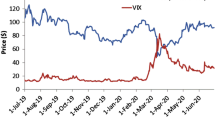Abstract
Valuing high-dimensional options has many important applications in finance but when the true distributions are unknown or complex, numerical approximations must be used. Approximation methods based on Monte-Carlo simulation show a steep trade-off between estimation accuracy and computational efficiency. This article presents an alternative semi-analytic approximation method for pricing options on the maximum or minimum of multiple assets with unknown distributions. Computational efficiency is shown to improve significantly without sacrificing estimation accuracy. The method is illustrated with applications to options on underlying assets with mean-reverting prices, time-dependent correlations, and stochastic volatility
Similar content being viewed by others
References
Audet N., Heiskanen P., Keppo J., Vehvilainen I. (2004). Modeling electricity forward curve dynamics in the Nordic market. In: Bunn D.W (eds). Modeling prices in competitive electricity market. Wiley series in financial economics, Wiley, New York
Boyle P.P. (1989). The quality option and the timing option in futures contracts. J Finan 44:101–113
Boyle P.P., Tse Y.K. (1990). An algorithm for computing values of options on the maximum or minimum of several assets. J Financ Quant Anal 25:215–227
Clark C. (1961). The greatest of a finite set of random variables. Oper Res 9:145–162
Cox J.C., Ingersoll J.E. Jr., Ross S.A. (1981). A re-examination of traditional hypotheses about the term structure of interest rates. J Finan 36:766–799
Cox J.C., Ingersoll J.E. Jr., Ross S.A. (1985). A theory of the term structure of interest rates. Econometrica 53:385–408
Deng S.J. (2005). Valuation of investment and opportunity-to-invest in power generation assets with spikes in electricity price. Manager Finan 31:95–115
Duffie D., Richardson H.R. (1991). Mean-variance hedging in continuous time. Ann Appl Prob 1:1–15
Geman, H., Roncoroni, A.: Understanding the fine structure of electricity prices. J Bus 79 (forthcoming) (2006)
Heston S.L. (1993). A closed-form solution for options with stochastic volatility with applications to bond and currency options. Rev Financ Stud 6:327–343
Hull J. (2006). Options, futures, and other derivatives, 6th edn. Prentice Hall, New Jersey
Hull J., White A. (1994a). Numerical procedures for implementing term structure models I: single-factor models. J Derivatives 2:7–16
Hull J., White A. (1994b). Numerical procedures for implementing term structure models II: Two-factor models. J Derivatives 2:37–48
Johnson H. (1987). Options on the maximum or the minimum of several assets. J Financ Quant Anal 22:277–283
Koekebakker S., Ollmar F.: Forward curve dynamics in the Nordic electricity market, Preprint, Norwegian School of Economics and Business Administration (2001)
Margrabe W. (1978). The value of an option to exchange one asset for another. J Finan 33:177–186
Ronald, H., Mahieu, R.: Regime jumps in electricity prices, ERIM Report Series Research in Management (2001)
Stulz R.M. (1982). Options on the minimum or the maximum of two risky assets: analysis and applications. J Financ Econ 10:161–185
Vasicek O.A. (1977). An equilibrium characterization of the term structure. J Financ Econ 5:177–188
Author information
Authors and Affiliations
Corresponding author
Additional information
The authors would like to thank the two anonymous referees, the associate editor, and Dr. Jess H. Chua at the University of Calgary for valuable comments and insights on this research. This research was partly supported by NUS grant R-146-000-059-112
Rights and permissions
About this article
Cite this article
Li, X., Wu, Z. A semi-analytic method for valuing high-dimensional options on the maximum and minimum of multiple assets. Annals of Finance 2, 179–205 (2006). https://doi.org/10.1007/s10436-005-0034-7
Received:
Accepted:
Published:
Issue Date:
DOI: https://doi.org/10.1007/s10436-005-0034-7



